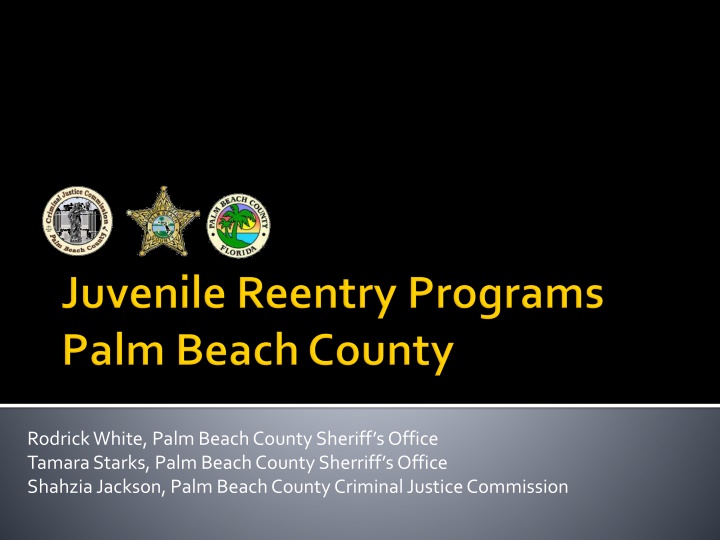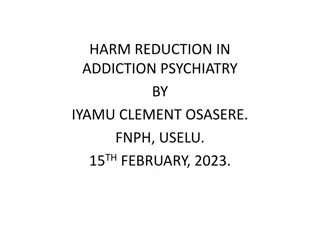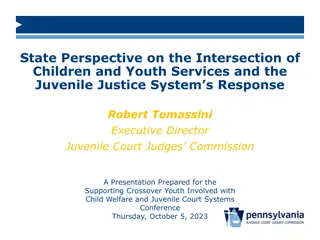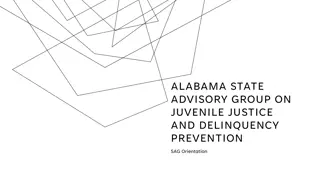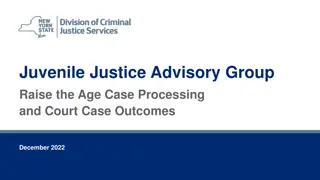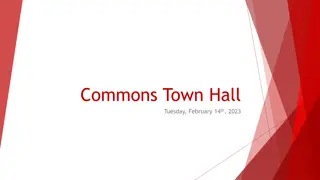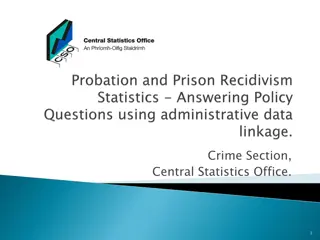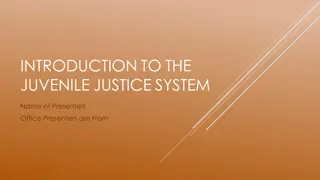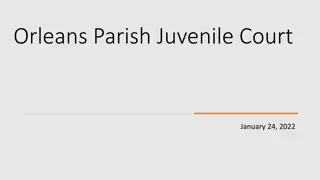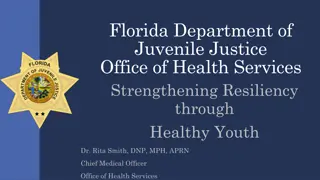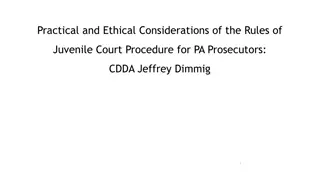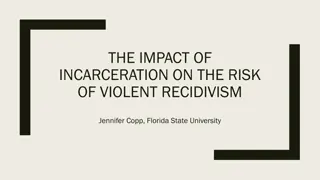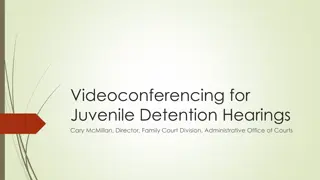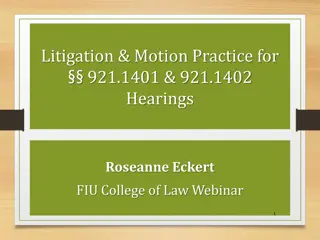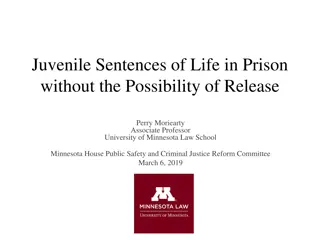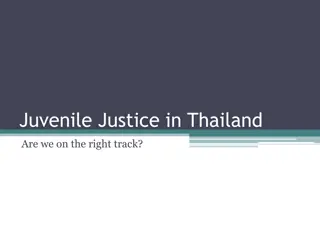Effective Strategies for Juvenile Recidivism Reduction
Study findings from Palm Beach County highlight significant statistics related to juvenile offenders, such as recidivism rates, mental health issues, and involvement in foster care or gangs. The importance of reentry programs and core principles for reducing recidivism are discussed, emphasizing the need for tailored services based on risk assessments, evidence-based programs, and a coordinated approach to address youth needs. Objective assessment of criminogenic risk and targeted interventions are key strategies to improve outcomes for juvenile offenders.
Download Presentation

Please find below an Image/Link to download the presentation.
The content on the website is provided AS IS for your information and personal use only. It may not be sold, licensed, or shared on other websites without obtaining consent from the author.If you encounter any issues during the download, it is possible that the publisher has removed the file from their server.
You are allowed to download the files provided on this website for personal or commercial use, subject to the condition that they are used lawfully. All files are the property of their respective owners.
The content on the website is provided AS IS for your information and personal use only. It may not be sold, licensed, or shared on other websites without obtaining consent from the author.
E N D
Presentation Transcript
https://encrypted-tbn0.gstatic.com/images?q=tbn:ANd9GcRzKiKoA976ol5YttZ8ypF6GeVmMtE6Eri2IFSja8iRaBPHb4fGaVfiQF8https://encrypted-tbn0.gstatic.com/images?q=tbn:ANd9GcRzKiKoA976ol5YttZ8ypF6GeVmMtE6Eri2IFSja8iRaBPHb4fGaVfiQF8 https://encrypted-tbn3.gstatic.com/images?q=tbn:ANd9GcRHnzpCnuSv4Lrfn7f86UtV8pTaux9SYaYul_h4vw-Yn-C1BjnRN-q-tQ4 RodrickWhite, Palm Beach County Sheriff s Office Tamara Starks, Palm Beach County Sherriff s Office Shahzia Jackson, Palm Beach County Criminal Justice Commission
Based on a study of 42 juveniles (2012): *Recidivism rate in PBC is 50% (re-arrest) for juveniles 33% had a mental health illness 31% were on psychotropic medication at some point 24% gang involved 5% in foster care Data Source: 2012 study of Palm Beach County juveniles returning home from commitment and county jail done by the University of Miami *currently working on adjudication/conviction recidivism rate
Reentry refers to the transition of offenders from prisons or jails back into the community http://www.capps-mi.org/wp-content/uploads/2013/02/reentry-support.jpg Bureau of Justice Assistance: Center for Program Evaluation and Performance Measurement
Principle 1: Base supervision, service, and resource-allocation decisions on the results of validated risk and needs assessments. Principle 2: Adopt and effectively implement programs and services demonstrated to reduce recidivism and improve other youth outcomes, and use data to evaluate system performance and direct system improvements. Principle 3: Employ a coordinated approach across service systems to address youth s needs. Principle 4: Tailor system policies, programs, and supervision to reflect the distinct developmental needs of adolescents. Core Principles for Reducing Recidivism and Improving Other Outcomes for Youth in The Juvenile Justice System , Council of State Governments
Objective assessment of criminogenic risk and needs Engage in practice that enhances intrinsic motivation in offenders Target higher-risk offenders Address offenders greatest criminogenic needs Use cognitive-behavioral interventions Determine dosage and intensity of services
Cognitive interventions (Thinking for A Change, Aggression Replacement) Motivational Interviewing
BCC Mayor, Shelley Vana CJC Chair, William L. Kramer Palm Beach County Reentry Task Force Chair, Carey Haughwout Employment Subcommittee Chair, Michelle Dryer Data and Evaluation Subcommittee Chair, Jennifer Loyless Juvenile Population Subcommittee Chair, Judge Kathleen Kroll Reentry Housing Subcommitee Chair, Daniel Gibson Sustainability Subcommittee Chair, Diana Stanely Mental Wellness Subcommittee Chair, Marsha Martino
Reduce recidivism and promote public safety by implementing a coordinated and comprehensive individualized transition plan for each youth based on his or her risks, needs, and strengths. Agencies from the juvenile justice and social services systems will collaborate to design a client-centered, trauma-informed reentry planning process using traditional and nontraditional resources driven by an evidence-based assessment tool, focusing on an individualized transition plan from the time of the youth s commitment to out-of-home placement through the period of incarceration, to the periods of transition, reintegration, and aftercare in the community.
Faith-based Education Reentry
Education Transition Meetings Youth meets providers Transition Planning
Began in early 2014 Funded by OJJDP BTAF is a Palm Beach County Initiative for juveniles returning home from commitment and County Jail Eligibility: Under 18 at enrollment, assessed as mod-high risk, and returning home from residential commitment or County Jail Developed by the Juvenile Reentry Subcommittee
University of Miami Department of Juvenile Justice Palm Beach County Sheriff s Office Gulfstream Goodwill Choice to Change The Lord s Place Palm Beach County School District
Antisocial behaviors, patterns, cognition, and peers Aggression Replacement Training Life Skills Family Family Intervention Choice to Change 102 School/Work Job readiness, GED, Vocational school, education assistance Leisure/Recreation Pro-social activities Substance abuse/Mental Health Mental health and/or substance abuse counseling Support groups
Case management Restitution & community service And other individual needs New! Reentry Hearings New! Mentoring
Reentry Pre- Release Hearing
To date: 96 juveniles served 25 re-arrests 26% re-arrest recidivism rate 78 are in school and/or employed
Systems resistant to change Funding Linking juveniles to appropriate treatment Lack of family support Lack of appropriate educational and/or vocational settings
